
- Afhalen na 1 uur in een winkel met voorraad
- Gratis thuislevering in België vanaf € 30
- Ruim aanbod met 7 miljoen producten
- Afhalen na 1 uur in een winkel met voorraad
- Gratis thuislevering in België vanaf € 30
- Ruim aanbod met 7 miljoen producten
Zoeken
Fourth State of the Union Address E-BOOK
A Historical Perspective on American Politics and Society
James Buchanan
E-book | Engels
€ 1,99
+ 1 punten
Omschrijving
James Buchanan's 'Fourth State of the Union Address' is a poignant commentary on the state of the nation during a critical period in American history. Written in a straightforward and clear style, the address covers a wide range of topics, including economic policy, foreign relations, and the issue of slavery. Buchanan's literary context is deeply embedded in the political climate of the mid-19th century, providing readers with a valuable insight into the mindset of the nation's leaders during this tumultuous time. The address serves as a primary source for historians and political scholars seeking to understand the challenges facing the United States during the antebellum era. It is a must-read for anyone interested in American history or political rhetoric. James Buchanan, as the 15th President of the United States, was uniquely positioned to address the pressing issues of his time. His experience in politics and diplomacy shines through in this address, showcasing his dedication to finding solutions to the nation's most pressing problems. Buchanan's 'Fourth State of the Union Address' is a compelling read that offers valuable insights into the political landscape of the mid-19th century and remains relevant for contemporary readers interested in the history of American democracy.
Specificaties
Betrokkenen
- Auteur(s):
- Uitgeverij:
Inhoud
- Aantal bladzijden:
- 37
- Taal:
- Engels
Eigenschappen
- Productcode (EAN):
- 4064066441531
- Verschijningsdatum:
- 7/12/2020
- Uitvoering:
- E-book
- Beveiligd met:
- Digital watermarking
- Formaat:
- ePub

Alleen bij Standaard Boekhandel
+ 1 punten op je klantenkaart van Standaard Boekhandel
Beoordelingen
We publiceren alleen reviews die voldoen aan de voorwaarden voor reviews. Bekijk onze voorwaarden voor reviews.








